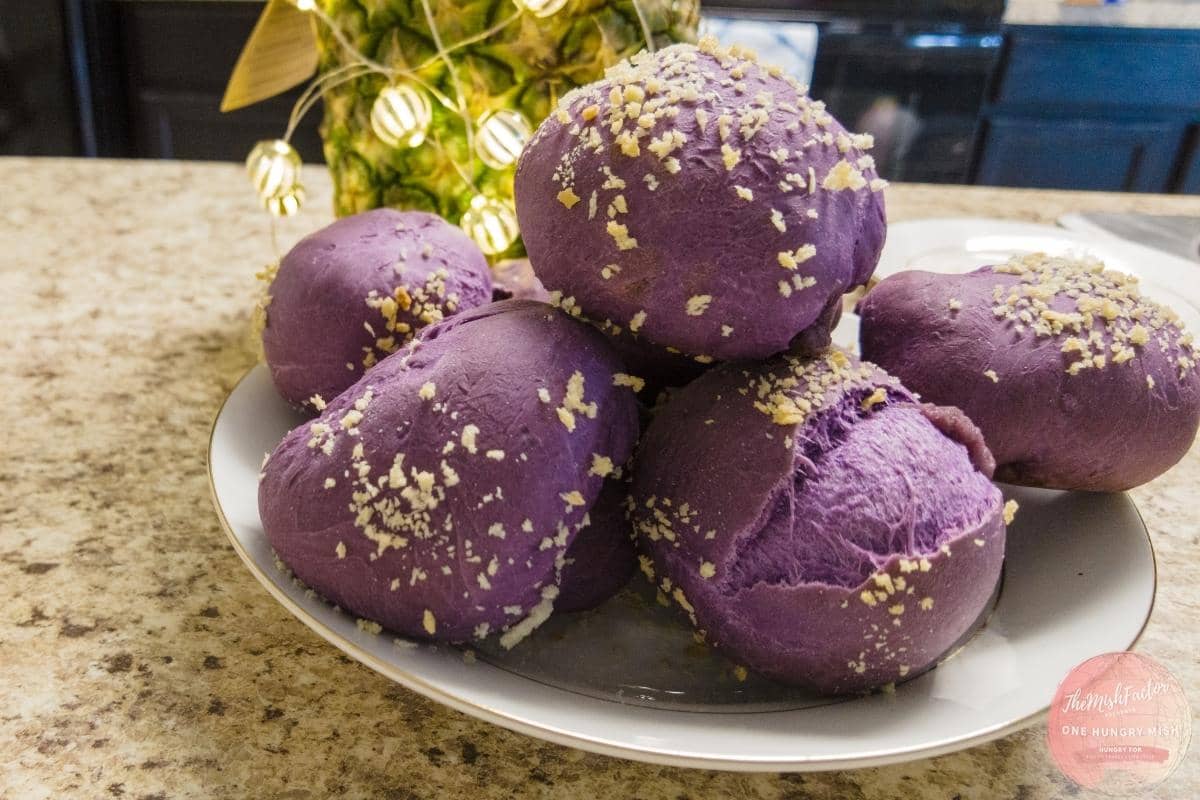Nothing says home for the holidays like nostalgic fare. After over a year since seeing pamilya in Southern Mindanao, it’s only fair that my mom is included in the nostalgia train. After all, holidays bring about a time of reflection. One thing she’s been craving–almost religiously since I shared her that Ube Pie from last post, is pandesal (pan de sal). In this case not any pandesal, but ube pandesal. And who am I to decline making pandesal with her (and formalizing my pandesal recipe), while sharing with those who trounce upon this blog the history, and of course deliciousness that is the morning bread of my people.

What is pandesal?
For those who haven’t had pandesal before, it is a bread close to the hearts of many Filpinos. Historically, the literal Spanish influenced translation would be accurate–salt bread. However, pandesal of today is a fluffy, slightly sweet roll that often frequents pinoy households on the daily. Like most bready baked goods, this was a creature of Spanish influence. The original being a hard, functional bread that inspires little to be talked about. Today’s bread is a softer due to the use of milk instead of water, and additionaof sugar.

“Pandesalllllllll” A cry nostalgic to many
I have memories of hearing the morning pandesal boy (or street hawker more aptly put) calling their pandesal cries outward, with the equal response from those looking to buy the bread. This may seem unusual to some, but given the tall maze-like structure of neighborhoods, this really was the only way to find someone if they were not familiar with the area. Street signs in neighborhoods are not commonplace, and often turns zigzag. If my Lolo and Lola ever moved I’d have been lost! My memory is a literal, turn right at the 3rd small shop, left at the palm tree, etcetera etcetera until the familiar pink walls of their neighbor’s house and my grandparent’s front gate popped into view.
To Ube or Not to Ube, That is the Question
Personally…and this probably sounds scandalous given my mom’s been craving ube pandesal enough to merit this post…I like pandesal old school. No ube. Just fresh and pure, and ready to have with hot coffee, hot chocolate, or even to toast with a slice of cheese between the soft yet crunchy bread. That said, pandesal filled with ube still is delightful, just more dessert filled and more “ensaymada” reminiscent to me.

Pandesal Recipe (Pan de sal Recipe)
Ingredients
- 3g instant yeast*
- 240g whole milk, warm (1 cup)
- 2 eggs
- 60g unsalted butter, room temperature OR melted** (1/2 stick)
- 500g Bread or All Purpose Flour⁺ (~4 cups + 1 Tbsp)
- 15g sugar (~1 Tbsp)
- 7g salt (~1 heaping tsp)
Ube twist - 5mL ube flavoring/color (1tsp)
Ube twist max (filled pandesal) - ube halaya (canned or fresh)⁺⁺
Other Tools - Parchment paper
- Food scale (strongly recommended)
- Rolling pin (optional)

Steps
- Combine wet ingredients (milk, eggs, and butter) and instant yeast until well incorporated. If doing “ube twist” add ube flavoring here.
- Sift dry ingredients (flour, sugar, and salt) together. If using a stand mixer, this should be the mixing bowl.
- Next, in small batches, add wet ingredients into dry ingredients bowl.
- If working by hand, turn out dough onto a floured surface and knead for 10 minutes until elastic and smooth. If working with a stand mixer, use the dough hook attachment and mix on low for 10 minutes or until smooth and elastic.
- Cover (and oil bowl if using a new bowl, aka hand kneading) dough in a large bowl. My preference is to cover with a wet towel. Set somewhere warm to prove/rise for 1.5-2 hours, or until size has doubled (time is contingent on temperature).
- After dough has doubled, preheat oven to 350F/177C.
If not making the “ube twist max” finish it as follows:
- On a lightly floured surface roll into either a log and cut into an equal 24 pieces. Can alternatively break into 24 rounded pieces. (Former is a traditional method, latter is popular for the home baker.)
- Gently roll surface in bread crumbs.
- Place spaced apart onto a lightly greased, parchment lined tray.
- Bake until golden brown (or a healthy light brown hue on the ube colored pandesal), about 15-20 minutes. Enjoy!
If making “ube twist max” finish it as follows:
- Create 24 rounded pieces (since it is filled it may make fewer than 24, closer to 22).
- Flatten a piece, place a grape size (~2 cm diameter) portion of ube halaya in center.
- Fold around the ube halaya until it is tightly sealed.
- Coat topside with bread crumbs.
- Place spaced apart, bread seal side down, onto a lightly greased parchment lined tray.
- Bake until golden brown (or a healthy light brown hue on the ube colored pandesal), about 15-20 minutes. Enjoy!
Notes
*If using dry active yeast steps are modified as follows:
Dissolve same amount of dry active yeast in 60mL (~1/4 cup) warm water, let sit for 10 minutes, then add to wet ingredients. Follow rest of steps as originally written above.
**Recommend melted butter if mixing by hand
⁺ If using all purpose flour make sure to really knead the dough, bread dough will make for a more tender pandesal with ease compared to all purpose
⁺⁺ If making fresh ube halaya, combine equal parts in weight of coconut milk to cooked/pureed ube in a pot on medium high. Stir, adding sugar to taste. Cook down until ube halaya is thick, will thicken further as it cools.

Stay Hungry
XOXO
Mish ❤

